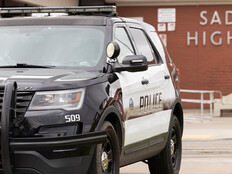Locking Screens and Detecting Noise for Potential Threats
Educators already are using technology to address students’ misbehavior in the classroom, such as locking screens during testing to deter cheating or online distractions. Those features are also baked into tools such as Google Forms.
Educators are also using emerging technologies and tools, such as augmented reality, 3D printers and robots, to teach students about empathy and ethics, tying community service projects to STEM instruction.
Other digital tools, such as the Wi-Fi enabled sensor FlySense by Soter Technologies, enable schools to track and predict fighting, smoking and bullying. Officials install the devices in areas where cameras and microphones can’t go, such as bathrooms and locker rooms, to detect anomalies in air quality that can be caused by vaping as well as changes in noise level that might indicate violence.
With artificial intelligence, web monitoring services can gauge the content of searches and communication, distinguishing harmless activities from potential signs of students in crisis — and minimizing false alarms to administrators.
The technology trends underscore how K–12 school administrators’ work isn’t limited to the core mission of teaching and learning — they also have to keep students and employees safe.
That also includes helping students protect their reputations. Jolley noted an example from three years ago, when Harvard rescinded acceptances of at least 10 students who shared inappropriate memes in a private Facebook group chat.
Lightspeed Systems’ Relay is another tool that continuously scans student online activities, such as emails, web searches and G Suite documents, for keywords that might indicate trouble. The service “has literally saved lives in our district,” Christina Gremillion, supervisor of instructional technology at Louisiana’s Caddo Parish Schools, stated in a news release. “We have discovered situations that students were going through with the use of this platform and have been able to provide interventions to keep students safe, healthy and happy.”
William McCauley, technology director for Morgan County R-1 School District in Stover, Mo., had similar praise for the service. He previously told EdTech that, less than a year after implementation, Relay helped the district avoid four potential crisis situations.
Monitoring Activity to Save Students’ Lives
The technology extends the focus on student safety beyond the classroom and the schoolhouse door. That includes deploying software and other digital tools to keep students from harming themselves. Intentional self-harm, or suicide, is the second-leading cause of death of people ages 15 to 24, according to the Centers for Disease Control and Prevention, and the third-leading cause of death for children ages 5 to 14.
In early January, Software as a Service provider GoGuardian announced three new variations of Beacon, its suicide and self-harm alert service for schools, including a no-cost option. Beacon 24/7, the newest version of the service, sends schools alerts “that provide context and human review of information — indicating when immediate escalation is necessary,” according to a company news release.
“Student depression and suicidal ideation are serious issues, and schools are trying to use a variety of resources to identify students in need as early as possible so they can effectively intervene and help. As students spend so much of their time online, schools understand the importance of software services that can complement their counseling programs,” Ellen Yan, general manager and student wellness advocate at GoGuardian, said in the news release.
The focus on students’ mental health is also important given a shortage of K–12 school counselors. In most states, the ratio of students to counselors is much higher than 250 to 1, which is the ratio the American School Counselor Association recommends. The national average is 442 to 1.
At FETC, Jolley recalled Securly analysts alerting officials to an email a student sent to a friend about her plans to kill herself that night. The monitors notified local law enforcement, who did a welfare check, Jolley said.
Tools such as Securly also include features — such as a tip line and an app that’s in development — that allow students to anonymously report incidents. When there’s trouble, ranging from an unauthorized party when parents are out of town to violent incidents, “kids know,” Jolley said. But they’re often afraid to tell.
He said he knows there are students who are able to go home at night, but might not have if not for the administrators using technology his company produces — “if it weren’t for us and what we’re doing.”











